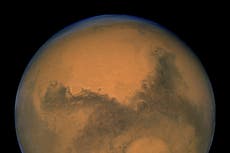Nasa Mars lander study reveals ‘main source of heat’ on Red Planet
About 50-70 per cent of heat-producing elements found on Red Planet’s crust by scientists
The main source of heat on Mars is from the decay over time of radioactive elements like Uranium – deep in the Red Planet’s interior, according to a new study.
Scientists, including those from ETH Zurich in Germany, also estimated the thickness of the Martian crust by analysing seismic data obtained by Nasa’s InSight lander.
The research, published recently in the journal Geophysical Research Letters,assessed Marsquakes data, including a powerful 4.6-magnitude quake that struck the planet in May 2022, said to be the largest one recorded during the entire InSight mission.
“We were fortunate to observe this quake... This marsquake sent out strong seismic waves that traveled along the surface of Mars,” study co-author Doyeon Kim from ETH Zurich said in a statement, adding that the waves “circled Mars up to three times”.
By measuring how fast the waves propagated at different frequencies, researchers could gain insights into the interior structure of Mars at different depths.
The new analysis helped scientists determine the thickness of the Martian crust, which they found averages 42-56km (26-35 miles).
In comparison, the average thickness of the Earth’s crust ranges from 21-27km (13-17 miles).
“This means that the Martian crust is much thicker than that of the Earth or the Moon,” Dr Kim said.
Scientists also found – based on the seismic data – that the density of the Martian crust in the northern lowlands and the southern highlands was similar.
In contrast, they said the crust in the southern hemisphere extends to a greater depth than in the northern hemisphere.
The findings also reveal how the Red Planet generates heat – shedding more light on Mars’ thermal history.
Researchers said the main source of heat produced in the interior of Mars currently is a result of the decay of radioactive elements such as Thorium, Uranium and Potassium.
About 50-70 per cent of these heat-producing elements are found in the Martian crust, the study found.
Scientists believe this high accumulation of such radioactive elements could explain why there are local regions in the planet’s interior where melting processes may still be taking place today.
“Together with thermal evolution models, a thick martian crust suggests that the crust must contain 50-70 per cent of the total heat production to explain present-day local melt zones in the interior of Mars,” researchers wrote in the study.
Join our commenting forum
Join thought-provoking conversations, follow other Independent readers and see their replies
Comments


Bookmark popover
Removed from bookmarks